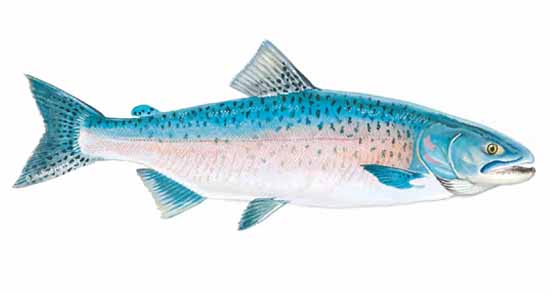Salmon, Pink
Published on
January 23, 2014

The “can-friendly” pink is the smallest and most plentiful of the wild salmon, accounting for the lion’s share of the canned pack. That pink salmon mostly winds up in cans is due partly to its habit of showing up in huge schools during short periods of time and requiring rapid, high-volume processing. However, pinks are increasingly entering the fresh and frozen markets. And some canners have taken a step forward with boneless, skinless pink fillets packed in a retort pouch. The male pink’s pronounced hump at breeding time has given the fish its colloquial name, “humpback.” Pink salmon can weigh up to 12 pounds, but the range of those caught commercially is 2 to 6 pounds. Pinks are found on both sides of the North Pacific, from Puget Sound to Alaska and from Russia to North Korea, including the Bering Sea. They are taken by gillnets and seines and by trolling. They are not farmed.
Oncorhynchus gorbuscha
Pink or humpback salmon
Pink salmon, humpy
Saumon rose
Buckellachs
Salmone rosa
Sepparimasu
Salmon Rosado
The “can-friendly” pink is the smallest and most plentiful of the wild salmon, accounting for the lion’s share of the canned pack. That pink salmon mostly winds up in cans is due partly to its habit of showing up in huge schools during short periods of time and requiring rapid, high-volume processing. However, pinks are increasingly entering the fresh and frozen markets. And some canners have taken a step forward with boneless, skinless pink fillets packed in a retort pouch. The male pink’s pronounced hump at breeding time has given the fish its colloquial name, “humpback.” Pink salmon can weigh up to 12 pounds, but the range of those caught commercially is 2 to 6 pounds. Pinks are found on both sides of the North Pacific, from Puget Sound to Alaska and from Russia to North Korea, including the Bering Sea. They are taken by gillnets and seines and by trolling. They are not farmed.
A generally lean and mild-flavored fish, pink salmon has meat that is low in oil and small-flaked. As the name implies, this salmon’s flesh is truly pink. The color is paler than the meat of the other salmon species and lacks the orange tint. It also has softer meat than most salmon.Pink salmon eggs are the second most valuable (behind those of chums) for salmon caviar.
| Calories: | 116 |
| Fat Calories: | 32 |
| Total Fat: | 3.5 g |
| Saturated Fat: | 0.6 g |
| Cholesterol: | 52 mg |
| Sodium: | 67 mg |
| Protein: | 19.9 g |
| Omega 3: | 1.1 g |
With their low fat content, pinks don’t grill as well as other salmon. Whatever cooking method you choose, it’s important not to let the lean meat dry out. Cook with moist heat or baste frequently while cooking. Pinks also work well in chowders, sandwiches, pasta preparations, casseroles and salads.
Chum salmon, Rainbow trout
- Bake
- Boil
- Broil
- Fry
- Grill
- Pate
- Poach
- Saute
- Smoke
- Steam
Fresh: Dressed
Frozen: H&G, Blocks
Value-added: Canned (most common form), Caviar, Smoked, Roasts
Canada, Japan, Russia, United States





